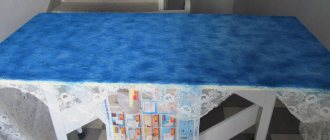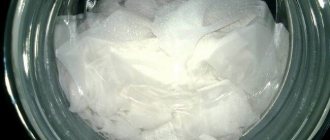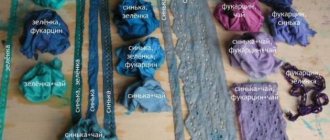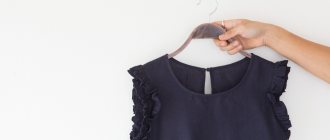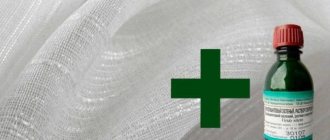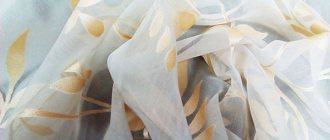Beautiful and neat tulle gives your home interior a cozy and warm atmosphere. In addition to washing, something as simple as starch allows you to keep your curtains clean. Today, fewer and fewer housewives spend time on this. Many people no longer remember how to starch tulle. However, a simple procedure not only gives the curtains an aesthetic and neat appearance, but also has practical value.
Why starch tulle?
Create a feeling of coziness and celebration at home, prolong the purity of the product, give clarity to the openwork pattern - all this is possible thanks to one procedure. You just need to starch the curtains from time to time. They become much easier to care for. After all, finishing not only improves the appearance of curtains, but also extends their shelf life and prevents contamination.
The following advantages of starch can be highlighted:
- gives the fabric density;
- the tulle pattern becomes clearer;
- the interior looks tidier;
- the fabric does not wrinkle and keeps its shape;
- you can make a beautiful drapery;
- white curtains look fresher and lighter;
- tulle gets dirty less and is easier to wash.
Starched items are much easier to wash. After all, polysaccharides form a protective film on fabric. Starch envelops the threads, increasing their wear resistance. The resulting film does not allow dirt and dust to pass into the fibers. When it's time to clean, water dissolves the protective barrier, and dirt is easily washed away with soap or washing powder.
Pet owners will appreciate another benefit of finishing. Urine stains are notoriously difficult to remove, especially on white fabric. They are not easy to handle even with an automatic machine. And constantly washing voluminous tulle is a labor-intensive task. But if the curtains are starched, they do not need to be removed. It is enough to temporarily immerse the contaminated area in a container of water, and then wash it immediately.
Basic rules for starching tulle
Whether tulle starches well or poorly depends on the solution used during the manipulation. The main ingredients of a high-quality starch solution are:
- water;
- starch.
Starch is made from rice, potatoes, corn and wheat. The properties of starch are the same, but the shade is different. For example, if the substance is taken from potatoes, the color is white with blue. This substance thickens quickly, which cannot be said about corn starch.
Before treating things with starch, they must be washed and then rinsed. If you starch dirty tulle, the film will seal the dirt and it will become visible to everyone. It is difficult to wash it afterwards. Clean material is placed in a solution with starch. At the same time, it should not be wet, but moist. Dry curtains can also be starched.
Preparation for the procedure
Before you starch tulle or curtains at home, you need to clean them of dirt and stains. To do this, several stages of preparation for finishing are carried out.
Soak
The tulle is soaked in the cleaning solution for several hours. Add a tablespoon of soda or powder to 10 liters of warm water. Liquid laundry soap or table salt will also work. The solution can be changed several times depending on how severe the degree of contamination is.
Washing and bleaching
After soaking, you can start washing. Dissolve the powder in water. The temperature should not exceed 40-50 degrees. During the procedure, squeeze the fabric slightly, lifting it above the water and lowering it back into the container. Try not to rub the edges of the curtain against each other, this will ruin the quality of the tulle and lead to deformation of the fibers.
Not all fabrics are suitable for aggressive household chemicals. Since tulle is made from chiffon, cotton, nylon, organza and other airy materials, the detergent is selected individually, depending on the type of fabric. In addition to store-bought powders, there are a lot of cheap homemade bleaches.
| Material | How to wash and bleach | What to watch out for |
| Chiffon |
|
|
| Capron |
|
|
| Organza |
|
|
| Cotton |
| (unpretentious) |
| Veil |
|
|
Housewives face the greatest troubles when washing voile curtains. This thin material absorbs dust faster than others. To completely remove dust from it, a long soaking in the active composition is required.
You can bleach nylon curtains with regular table salt. This is a safe method. Such curtains can even be hung in the bedroom of a child with allergies. The only negative is the processing time. The tulle needs to be kept in the solution for 6 to 8 hours, so it is better to soak it overnight. The pre-washed curtain is placed in a bucket of water and 200 g of salt. In the morning, the material needs to be rinsed.
Rinsing
After washing and removing stains, the curtains are rinsed twice: in warm and cold water. The main thing is not to twist or squeeze the tulle. Otherwise, this will lead to deformation and rapid wear of the fabric.
How to starch curtains
There are several ways to starch tulle fabric. You can do this by hand or in a washing machine; prepare a rare, medium or thick solution; give the curtains shape using starch or other means.
Depending on the density of the solution, the following processing methods are distinguished:
- Soft method (a teaspoon of starch per liter of water) for curtains and tulle.
- Medium (tablespoon per 1 liter) for lace, napkins, shirts, aprons.
- Hard (2 tablespoons per liter of water) for collars and cuffs.
For curtains and curtains, a soft method is used. It protects the fabric and gives it a fresh look without making the fibers stiff. For the procedure, you can use processed products from rice, wheat, and corn. But the most popular is potato starch. It is affordable, viscous, thickens quickly and effectively whitens fabric. If the starch has a grayish tint, it should be washed well, drained and allowed to dry.
Soft finishing stages
The procedure involves soaking clean dry or wet tulle in a starch solution. To do this you need to follow these steps:
- dissolve 5 teaspoons of starch in 200 ml of cold water;
- stir thoroughly;
- Heat 5 liters of water in a separate container;
- Stirring constantly, pour in the resulting starch solution in a thin stream;
- cook over low heat until a clear paste forms;
- turn off the fire;
- strain through a sieve or cheesecloth to avoid lumps;
- if the liquid is cloudy, boil for 5 minutes;
- if the curtain needs to be given shine, add a spoonful of salt or sugar;
- cool the solution to room temperature;
- pour the liquid into a basin or bucket;
- immerse clean tulle in the solution for half an hour;
- remove the fabric and let the water drain.
Remember that it is not recommended to wring the tulle too hard. If corn starch is used, the solution must be boiled. To give light curtains a “frosty freshness,” add a little blue to the finishing liquid.
Starching in the washing machine
You can finish curtains not only by hand. To do this, paste or dry starch is dissolved in water in the required proportion and poured into the conditioner compartment. Then the machine turns on to standard mode. After stopping, you can pull out the curtain and dry it.
Method without soaking
This recipe is suitable not only for tulle, but also for colored fabrics. The main condition is to process dry material. In a liter of warm water you need to dissolve a quarter teaspoon of starch. The paste is boiled for 7 minutes and cooled. The resulting liquid should be poured into a spray bottle and applied to dry and clean curtains. If desired, the tulle can be ironed after spraying.
Other recipes with starch
There are several more recipes for starching things using starch:
- Aerosol. Suitable for individual elements and colored fabrics. Combine 1 liter of warm water and 1/4 small spoon of starch, boil for 5 minutes and cool. The solution should be poured into a spray bottle and treated with dry fabric, then ironed. This aerosol can be purchased ready-made.
- Gloss-starch. Gives products not only shape, but also shine. You need to mix rice starch, talc and borax powder in a ratio of 5:3:1, then add a little cold water. A napkin is moistened in the solution, which is then used to treat the item. Next, the product needs to be ironed.
Note: You can starch things not only by hand, but also in the washing machine. You should pour the soft starch solution into the conditioner compartment and turn on the standard washing cycle. Finally, it is important to wipe the drum and door with a clean, dry cloth.
Finishing without starch
The same effect can be achieved using other available products and special store-bought formulations. These preparations are suitable for synthetic curtains that are not affected by potato starch. It is better to coat materials with synthetic threads with special production mixtures or gelatin.
Sugar
The finishing solution is prepared in the following way:
- Dissolve 5 tbsp in a liter of boiling water. spoons of sugar.
- Cool the liquid.
- Immerse the tulle in warm water.
- Wait until it is soaked, remove it and let the solution drain.
This method has some nuances. In particular, do not boil sugar in water, otherwise the solution will turn yellow and stain the curtains. Another disadvantage of this method is that curtains with the smell of sweet syrup will attract insects into the house.
Gelatin
First you need to prepare a solution. 3 tablespoons of gelatin should be dissolved in 50 ml of cold water. Then the liquid is heated in a water bath. Gradually another half liter of water is added to it. The resulting solution must be dissolved in 4-5 liters of warm boiled water and the curtains should be immersed in it. The method is well suited for synthetic fabrics.
PVA glue
In some cases, glue is used for finishing. To do this, dissolve two teaspoons of PVA in a bucket of warm water. This method evens out the texture of the fabric, making it smoother and shiny. After this treatment, dust does not settle on the curtains for a long time.
Silicate glue
It works in the same way as PVA. To prepare the solution, you need to dilute a teaspoon of glue in a bucket of water. The tulle is dipped into the liquid for a couple of minutes, then dried. The method is suitable for delicate fabrics.
Industrial products
Modern industry offers special sprays and powders for finishing. Some drugs are made on the basis of polyvinyl acetate emulsion.
Special solutions and powders can be used for machine or hand washing. They need to be added to water according to the instructions on the package or poured into the conditioner compartment. The main thing is to do everything correctly and not to exceed the dosage, otherwise you will have to rinse the curtains again later.
Dry tulle can be starched using industrial aerosols. Such products are sprayed onto fabrics before ironing. Their advantage is that there are no streaks or light marks left on colored fabrics.
How to iron starched tulle
Before ironing the curtains, they must be properly wrung out and dried a little. In order not to damage the delicate tulle, it is better not to twist it, but simply remove it from the water, squeeze it lightly and let the water drain. After this, the fabric is shaken and hung to dry. Carefully straighten out all creases and folds. It is better to dry tulle in a well-ventilated room. Make sure that undried starch curtains are not exposed to frost, near a radiator, or in direct sunlight.
It is better to iron slightly under-dried curtains. Some housewives do not heat treat tulle because they are afraid of damaging the delicate fabric. They simply hang the curtains on the curtains, straighten them and let them dry like that. Indeed, if the iron is too hot, the tulle may melt or turn yellow. And if the curtains have not been wrung out, then after drying on the curtain they will be smooth and even.
But if the fabric has been wrung out and it is impossible to smooth out the creases, it is better to use an iron. Set it to moderately hot, no more than 120 degrees. Wrap the tulle fabric in cotton and iron it. The curtains should be slightly damp. If the finished material is dry, it is almost impossible to iron it. Do not use steam as this will cause the starch to lose its properties. Cotton cloth or gauze will prevent the iron from sticking to the tulle. A pinch of salt added to the starch solution helps reduce soot. For these purposes, you can also use a few drops of turpentine.
If synthetic curtains have turned gray or yellowed, you can dye them a subtle color. This is easy to do even at home, just purchase a special dye.
By following these instructions exactly, you will get beautiful, fresh and clean tulle. If for some reason you were unable to starch the curtains or you are not happy with the result, simply wash the tulle again.
Even the most beautiful things lose their appeal if not properly cared for. So, often after the first wash a full skirt loses its shape. This is especially true for products made of dense tulle and crepe de Chine. To restore the appearance of the product, you can use starch. There are several ways to starch a skirt. This can be done with home remedies or using ready-made household chemicals.
Benefits of starching tulle
When starched items become dry, an invisible film forms on them. The film settles tightly in the structure of the fabric, making the material dense and crispy. The ideal result is:
- tulle becomes stiff;
- holds its shape well;
- practically does not wrinkle.
When dust gets on the curtains, the protective film does not allow dust particles to penetrate into the deep layers of the fabric. The item does not deteriorate or get dirty; it can be washed quickly. However, starched tulle also has a drawback - if you hang the curtains over the entire window, air will not penetrate through them in the summer. That is why clothes are starched in detail, for example, only the cuffs or collar.
A little stiffness will definitely not interfere with curtains, curtains and tablecloths, napkins that are laid out on the coffee table.
Basic rules for starching a tulle skirt
Tulle is a medium-hard veil made of polyester thread. The fabric is used to make skirts, petticoats, and tutus. It is very important to starch tulle from time to time. This will not only give the product the necessary rigidity, but also protect the material from damage and contamination. Basic rules for starching tulle include the following information:
- It is forbidden to apply starch without first washing the product. Before the procedure, the skirt must be washed and dried. If you starch soiled clothes, it will be more difficult to get rid of stains in the future. Contaminants are literally imprinted into the fibers of the fabric.
- Starch is not suitable for dark products. Unfortunately, on a black or dark-colored skirt, the starch paste will leave multiple stains. To shape such products, it is worth using alternative methods: sugar solution or gelatin.
- A starched tulle product is afraid of moisture. The ingress of water is detrimental to the protective layer. That is why it is strictly forbidden to dry the product outside during low temperatures or after rain. In addition, it is better not to go outside in a starched skirt in bad weather.
It should be remembered that to add shine to a tulle product, you can add a pinch of soda to the starch. Just one spoon of turpentine poured into the paste will help make ironing easier.
What is the difference between starching tulle from different fabrics?
Some curtains require a particularly careful approach. For example, if they are made of tulle, the fabric is starched using a weak and medium solution. The tulle is placed in the paste for half an hour, then squeezed out, shaken and dried, hanging on a rope. When hanging curtains, it is important to straighten all folds and creases. There is no need to wait until the material has completely dried. Iron the fabric slightly damp.
Sometimes, instead of tulle, in private houses a gauze curtain is hung at the entrance to the house. In summer it protects the house from flies and insects. So, gauze curtains are starched with a hard solution. If the curtains are made of lace, a medium-hard paste is sprayed onto them and then ironed from the wrong side.
How to prepare a skirt
Before you starch your skirt at home, you should wash it according to the instructions on the label. Items made from tulle should preferably be washed by hand. For this:
- It is recommended to prepare the skirt itself. It is necessary to remove decorative elements from it: false lace, belt, brooches.
- Choice of remedy. For hand washing, special gels or liquid products are best suited. Due to the structure of the fabric, granules can remain on the surface and cause streaks.
- Select the correct water temperature. Any polyester-based fabrics should not be washed in hot water. The optimal temperature is 30 degrees.
- Do not twist or rub the product. Tulle is a rather fragile material that can tear due to rough handling.
- After washing, the product must be dried and all wrinkles smoothed out. You can start starching the product after it has completely dried. It is allowed to begin the procedure while the product is slightly damp.
A solution with the correct proportions
The advantage of using starch in powder is the ability to regulate the degree of hardness of the product. However, if there is no experience in this matter yet, then you should be guided by generally accepted proportions.
Table 1. Proportions recommended for starching a skirt.
Planned stiffness
(tsp per liter of water)
To carry out the procedure, you need to prepare starch milk. To do this, stir the required amount of starch in powder form in a liter of warm water. Then pour boiling water into the resulting solution in a thin stream, stirring constantly. As soon as the composition reaches the consistency of a paste, it can be used to starch the skirt. If there are lumps in the solution, it is recommended to first strain the composition through a sieve.
It is important to know that not only potato starch is suitable for making starch milk. It is quite possible to use any other one, for example, corn.
Step-by-step instruction
The procedure does not involve complex actions. How to starch a skirt at home:
- completely immerse the product in starch paste;
- keep the skirt in the solution for 5-7 minutes;
- make sure that there are no dry areas left;
- carefully remove the product and leave to drain;
- straighten all folds and dry vertically.
To achieve the best result, slightly damp items should be ironed at low temperatures. It is strictly forbidden to use steaming or a spray to moisten the material after complete drying - water instantly destroys the starch layer. You can also starch clothes automatically. To do this, the starch paste is placed in the conditioner compartment, and then the washing mode suitable for the fabric is set. In this case, adding conditioner or stain remover is completely eliminated. After the procedure, you must thoroughly wipe the drum and glass of the machine.
What means are suitable
Is it possible to starch tulle with food starch? This is a really good method, but sustainable results when processing fabric made from polyester thread can be achieved precisely by using ready-made household products. In some cases, it is much easier to shape an elegant skirt using a spray or aerosol. You can process the product for fullness directly on the person, straightening the layers to your liking. It is important that with some ready-made products you can add firmness to clothes made from dark fabrics without fear of encountering stains.
Table 2. By what means can you starch a skirt?
Product name
A universal liquid product for starching all types of fabric. Suitable for manual and machine care.
Starch in the form of an aerosol greatly simplifies the starching process. The product is applied to the product and then fixed with a warm iron.
A liquid product based on natural potato starch that makes washing and ironing easier.
How to shape a dark fabric skirt
In this case, gelatin with the addition of glycerin is better suited. The product will help to avoid a white coating on dark fabric and will eliminate the risk of gray stains. To shape the product you should:
- soak 20-30 grams of packaged gelatin in 500 milliliters of cold water;
- after 60 minutes, mix the resulting solution thoroughly in a water bath until the lumps are completely dissolved;
- Pour about 2 liters of cold water into the composition;
- add a couple of tablespoons of glycerin for elasticity;
- rinse things in the resulting solution after rinsing with warm water;
- straighten the product and dry vertically in a warm room with normal humidity.
Making a thing dense, giving shape to small parts, prolonging the cleanliness of a product - all this can be done with one procedure. You just need to starch the fabric. How to use starch at home and achieve the best results? Here is an overview of methods and a selection of tips for processing different types of textiles.
Recommendations
A selection of useful tips for starching:
- There is no need to starch products constantly. It is enough to repeat the procedure after 3-5 washes.
- When spinning, do not twist the fabric to avoid creases.
- If you need to starch lace guipure products, use milk instead of water, and rice starch instead of potato starch.
- Only clean items are allowed to starch. If clothes are dirty, wash them first and then starch them.
- If the starch solution becomes cloudy, boil it for 5 minutes.
- If the solution is thick, it can be diluted with a small amount of warm water and mixed.
- To give things shine, add a pinch of table salt to the water along with the starch. It will also prevent the iron from sticking to the fabric when ironing. Ironing will be made easier by adding 5-7 drops of turpentine to the solution.
- After starching, slightly damp items should be ironed. Try laying the product out and walking over it with a damp cloth. This will distribute the starch and remove any excess. Iron the back side first, then the front side. Heating is the weakest permissible for a certain type of fabric.
- Drying starched materials is done away from heating appliances. Things should not be exposed to direct sunlight or taken out into the cold.
- To prevent carbon deposits from forming on the iron, cover the starched fabric with gauze.
- If the starch has a grayish tint, it is first soaked in water, allowed to settle and filtered.
- If you fail to achieve the desired result from starching, simply wash the item again.
Grandma's method of giving a durable shape to products is still relevant. With simple steps using starch at home, you will also achieve shine and snow-white textiles. Use this affordable and simple method to give textiles special properties.
Why is this necessary?
Our grandmothers recommended starching fabric. And it’s not just about beauty, the procedure also has a practical side:
- Starched collars and other small details clearly hold their shape.
- Details of clothing look more formal.
- Wardrobe items treated in this way are less susceptible to wrinkling.
- Fabrics get dirty less and are easier to wash.
- In this way, white things are restored to their freshness of color.
How it works? It’s very simple: starch creates a thin protective film on the fiber. It makes matter denser and more elastic, and does not allow contamination to penetrate deep into the structure. When wet, the film dissolves and dirt can be easily washed off with simple detergents.
Why starch textiles, and when should you not do it?
During the process of starching the fabric, its fibers are impregnated with polysaccharides. A thin film is formed on the surface of the threads, which increases their density and elasticity. As a result of starching, textiles hold their given shape well, bleach, crumple less and “creak” when touched. In addition, products stay clean longer and are easier to wash, since the starch film repels dirt and does not allow it to penetrate deeply into the fibers.
The disadvantage of starching is the fact that it reduces the breathability of the fabric. It is not recommended to process:
- summer clothes (it is advisable to starch only individual parts);
- underwear (they may become stiff and cause discomfort);
- dark products (starch can change their shade);
- synthetic fabrics (the solution is not fixed to their fibers);
- things embroidered with floss threads (they can stick together and lose their shine).
Important: Only clean things are starched. If there are stains on the product, they must first be removed.
When not to resort to starching
Processing also has its downsides. As density increases, matter becomes rougher. Fabrics begin to let air through less well.
In what cases is it better to refuse the procedure:
- If the clothing is intended to be worn in hot weather.
- You should not starch your underwear so that it does not lose its hygroscopic properties and does not become hard or injure the skin.
- For the same reason, children's clothing is not treated.
- Do not experiment with colored or dark things: starch may well change the shade or leave streaks.
- Starching solution is not effective on synthetic fibers.
- Embroidery made from floss threads is handled with care. They can stick together unsightly and lose their shine.
Which state has the lowest taxes?
Where are the lowest taxes in the USA: top 10 states
- Delaware First on the list is a state that has no sales tax. ...
- Wyoming The reason why Wyoming residents have one of the lowest tax burdens in the country is their mineral and oil profits. ...
- Louisiana...
- Mississippi...
- Arizona...
- Alabama...
- Nevada...
- South Carolina
12 Feb. 2015
Types of starch and processing methods
There are three, and sometimes even four degrees of processing of fabrics with starch:
- soft (very soft still stands out): this treatment makes it possible to give elasticity to the fabric, but does not make it rigid;
- a medium degree of starch gives the products shape and helps refresh the white color;
- hard: this treatment is necessary for the durability of collars, cuffs and other parts.
Each method requires a certain proportion of substance and water. Potato starch is mainly used - it is the most popular and affordable. The substance thickens well, has a high degree of viscosity, and is distinguished by a snow-white tint. Other types of starch: rice, corn, wheat.
Basic Rules
What you need to know about starching, and how to properly starch clothes? First of all, the type of fabric is determined, then the appropriate starch concentration is selected. It is unlikely that you will process thin translucent tulle using a rigid method.
The next step is preparing the mixture:
- First you need to dilute the starch in a small amount of water.
- Heat the required amount of water in a saucepan.
- When it boils, add dissolved starch.
- Cook the paste over low heat until thickened, stirring constantly, or simply leave the pan on the cooling stove.
- Bring the solution to full volume by adding water.
Why is the starch composition prepared this way: if you pour the dry substance directly into boiling water, lumps will form that cannot be stirred. By pre-dissolving the starch, this situation is easier to avoid.
Advice! If there are still lumps in the pan, they are crushed by passing the mixture through a sieve.
The essence of starching is soaking the fabric in such a solution. The product can be either wet or dry. The procedure is carried out immediately after washing.
The nuances of starching fabrics of different types
- If you want to starch cotton and linen items, this can be done using traditional methods.
- Chiffon items need to be starched with weak solutions. A similar mixture is used to work with organza. This material can also be treated with a gelatin solution.
- To starch lace, a medium starch or glue solution is suitable. To work with tulle, use the same solution.
Now you know how to dilute starch and how to starch things correctly. There is nothing difficult about this if you follow all the tips.
The soft way
This is the starching option with the lowest concentration of raw materials. Bed linen, silk items, blouses, dresses made of chiffon or cambric are processed in a gentle way.
Method for bed linen:
- Dilute starch for starching in a bowl in the proportion of 1 tsp. for 150 ml of cold water.
- Mix well so that there are no lumps left.
- Bring 800-850 ml of water to a boil in a saucepan.
- Pour in the starch, stirring constantly, and turn off the stove.
- Cool the solution to room temperature. It should be transparent.
- Pour the mixture into a basin and immerse the bed linen in it for 1-2 minutes.
- Remove and squeeze well.
- When hanging, smooth out all folds and creases.
It is recommended to starch curtains and tulle using a gentle method:
- The proportions of starch and water are the same, that is, 1 liter of water (150-200 ml + 800-850 ml) per 1 teaspoon of raw materials.
- The tulle is soaked in the prepared cooled solution for half an hour.
- The fabric is wrung out and dried in a straightened state.
- It is recommended to iron tulle items while they are still slightly damp. Or hang it raw on the curtain and straighten it.
Advice! Soaking in a weak starch solution is replaced by spraying. After washing, treat the dried item with the solution using a spray bottle and iron. A good way for tulle.
What concentration should you dilute starch in?
Starch dilution must be carried out in certain proportions. It all depends on the purpose of the solution. More information about what concentration starch should be diluted to starch clothes will be discussed below.
Weak
If you prepare a weak solution of starch, you can use it to bleach things. This will also give it elasticity and resistance to dents. It can be used on shirts, children's formal wear, decorative pillowcases and doctor's uniforms. To preserve the shade, you can use a weak solution to starch colored items. However, make sure in advance that the item does not fade.
To prepare you will need 1 liter of water and 1 tsp. starch. The volume of the prepared solution depends on the purpose. For several shirts, 5 liters is enough. Be careful not to form lumps.
Instructions for preparing the solution:
- Heat the water to a temperature of +30°C. Pour the starch over it and carefully break up all the lumps.
- Heat the water over the fire to a temperature of +95°C.
- Pour the starch mixture into the water, stir, and remove from heat.
- When the mixture has cooled, you need to immerse things in it for a few minutes.
Afterwards, the clothes must be straightened and hung on hangers. When they dry, all the creases on them will disappear.
It is better to use a spray bottle for starching.
Spray the solution onto dry items and run an iron over the top.
Average
To prepare the solution you will need 1 tbsp. l. starch and 1 liter of water. This can improve the condition of aprons and tablecloths.
To brew the mixture, follow these instructions:
- Dilute 1 tbsp in 0.5 liters of water. l. starch.
- Boil the remaining volume of water and pour the previously prepared mixture into it.
- When the solution has cooled, you need to immerse clothes in it and starch for a quarter of an hour.
If you want to add extra shine to snow-white things, you can add 1 tsp to the solution. regular salt.
Hard
A similar mixture is used to starch cuffs, collars, petticoats and chef's hats. If you have fabric flowers at home, you can stiffen them with a stiff solution. With its help, you can improve the appearance of openwork summer shoes so that the tops are resistant. To prepare you will need 60 g of starch, 1 liter of water and 1 tsp. Boers. The last component can be purchased at your nearest pharmacy.
How to starch laundry with a hard solution:
- Heat 0.5 liters of water to a temperature of +25°C. Dilute the specified amount of starch in it.
- Heat 0.25 liters of water to a temperature of +40°C. Dilute borax in it.
- Boil 0.25 liters of water and add the previously prepared solutions to it. Mix thoroughly.
- Wait 2 hours for the mixture to infuse.
- When the mixture has cooled, soak things in it for half an hour.
- Wring out, straighten, and hang to dry.
Middle (regular) method
In this way, a certain shape is given to various products: shirts, curtains, tablecloths, napkins, lace. The proportions for the average starching method are approximately one tablespoon of starch per liter of water. The result is a translucent solution, similar to jelly.
The mixture is prepared in exactly the same way as in the soft method: first, the starch is diluted in a small amount of water, then added to boiling water in a saucepan, cooked and cooled. The length of time the product remains in the solution depends on the type of fabric:
- It is enough to keep tulle, organza and other delicate fabrics in the solution for a few seconds.
- Shirts, tablecloths and table napkins remain in the starch mixture for 10-15 minutes.
- Openwork napkins and other lace items will need 20 minutes.
Advice! Sometimes you need to starch a separate part of the product: flounce, bow, lace trim. To do this, take a sponge or piece of cloth, soak it in the prepared solution and smear the item of clothing. Wait 10-15 minutes, then cover the treated area with gauze and iron. You can also just wait until it dries completely.
Recommendations for drying and ironing
To ensure that the final result of your efforts is pleasing to the eye, it is important to properly dry and iron starched items. Basic recommendations:
- Products must be dried in a ventilated area. It is advisable not to place them in direct sunlight, on heating devices or in frost.
- It is better to dry shirts, dresses and bed linen in an upright position on hangers and lines, respectively. They should not be pressed too hard to prevent creases from forming.
- Openwork napkins and lace should be dried horizontally on a terry towel. They need to be well straightened, aligning all the elements, and pin the edges with pins. You can also use hoops and wooden frames.
- It is advisable to iron the products in a slightly damp state with a warm iron without steam, placing a thin cotton cloth or gauze on top to avoid sticking. Items with embroidery must be ironed from the inside out. Dried clothes are almost impossible to iron.
Starching textiles is an affordable way to make them look fresher and more attractive. It is important to choose the correct solution concentration depending on the type of fabric, level the wet product and iron it in time before it is completely dry. Dark wardrobe items, synthetics and underwear should not be subjected to this treatment. If you don’t like the effect of starching, just wash the item.
The hard way
A highly concentrated starch solution will help make the fabric stiff so that it “stands up.” You will need at least 2 tbsp. raw materials per liter of water. Petticoats, cuffs and collars, and textile decor are processed in this way. You can prepare the solution by analogy with the methods described above.
An alternative method using sodium boric salt - borax (you should buy it at the pharmacy):
- dissolve 50 g of starch in a glass of cold water;
- borax in the amount of 1 tsp. dissolve in a glass of hot water and cool;
- Boil three glasses of water;
- pour in starch, stirring;
- pour in the borax solution;
- leave for 2 hours.
To treat the product, immerse it in the prepared solution and wait a few minutes until the fabric is completely saturated. Then wring out, dry (not completely) and iron. The product will hold its shape tightly and, thanks to the borax, will gain gloss. What should you do if you need to starch a separate item of clothing, for example, a shirt collar and cuffs? Just dip only these parts into the solution.
Basic methods
When figuring out how to starch fabric with starch, you should know that the essence of the process is to soak the textile in a solution of plant materials and water. You can use a processed product from potatoes, corn, rice or wheat. The most commonly used starch is potato starch. It is inexpensive, gives things a bright white color and thickens well.
Before starching, the fabric should be washed and rinsed thoroughly. It may be wet or completely dry before being lowered into the solution. Depending on the concentration of the mixture, there are three processing methods:
- Soft. Allows you to give the product elasticity, but does not make it hard to the touch. Suitable for bed linen, blouses, dresses made of chiffon, cambric, silk.
- Average. Makes it possible to create a specific shape and refresh textiles. Used for tablecloths, napkins, men's shirts, furniture covers, curtains, lace, flounces.
- Hard. It is necessary if the question arises of how to starch the fabric so that it stands. Used for petticoats in fluffy dresses, cuffs, collars, decorative textile flowers.
In addition, the starching effect can be achieved without the use of starch. Gelatin, sugar and glue are used for these purposes.
Soft method for bed linen and tulle
When solving the problem of how to starch linen, we will consider in detail the soft processing method. The solution is prepared at the rate of 1 teaspoon of starch and 1 liter of water.
Stages:
- Pour starch into a small container and add 150-200 ml of cold water. Stir thoroughly so that there are no lumps.
- Boil the rest of the water. Pour in the concentrated starch solution while stirring constantly. Turn off the fire.
- Cool the liquid to room temperature. It should be transparent and leave a slippery mark on the skin if you put your hand into it.
- Pour the starch solution into a basin and immerse the bed linen in it for 1-2 minutes to soak it.
- Remove the fabric, wring it out and shake it off. Hang to dry. If possible, remove all creases and folds.
In addition, a soft solution can be used if a problem arises, how to starch tulle or curtains to make them look more elegant.
Stages:
- Combine starch with water according to the scheme described above.
- Immerse the tulle in the cooled solution for 30 minutes.
- Pull out the fabric. Squeeze out the liquid.
- Iron the tulle when it is slightly dry but still damp.
Note: If lumps form when preparing the starch solution, it should be filtered through a sieve and cheesecloth. If the liquid becomes cloudy, boil it for 5 minutes. To make things shiny as a result of starching, you can add a pinch of table salt to the solution.
Middle method for lace, napkins, shirts, school aprons
A medium-hard starch solution is made from 1 liter of water and 1 tablespoon of raw materials. The process of preparing the mixture is similar to the previous method. The result is a translucent, homogeneous liquid “jelly”. If the solution is too thick, add a little warm water to it and stir thoroughly.
The further algorithm of actions depends on the type of fabric. It is enough to dip tulle and other thin materials in starch liquid for a few seconds, lace and openwork napkins - for 20 minutes, tablecloths, table napkins and shirts - for 10-15 minutes.
If you need to starch a separate piece of clothing (ruffles, lace), you can prepare a solution and lubricate the decor with it using a piece of fabric or a sponge. After 10-15 minutes, the treated fragment should be covered with gauze and ironed with a warm iron.
Hard method for gauze, collars, cuffs
Let's figure out how to starch fabric heavily at home so that it holds its shape well . The solution can be prepared according to the previously described algorithm from 1 liter of water and 2 tablespoons of starch, or use another recipe.
Components:
- 1 liter of water;
- 50 g starch;
- 1 teaspoon of borax, that is, sodium boric salt, which can be bought at the pharmacy.
Preparation of a solution for hard starch:
- Dissolve starch in a glass of cold water.
- Dissolve borax in a glass of hot water. Cool to room temperature.
- Boil the remaining water. Stirring constantly, pour the starch into it.
- Add borax solution to the starch jelly. Wait 2 hours.
Let's look at how to starch gauze if a petticoat is made from it, and you want it to add fluffiness to the dress:
- Dip the product into the starch solution.
- As soon as the fabric is completely saturated, pull it out, wring it out and let it dry slightly.
- Iron the gauze, straightening out the folds while it is wet.
To starch the cuffs and collar of a shirt, only these elements need to be dipped into the solution. After 20 minutes, they should be taken out, squeezed out, dried and ironed thoroughly.
Is it possible to do without starch?
Starch does not work on products containing synthetic fiber. Other substances also give the starching effect:
- Sugar. For 100 ml of water - 200 g of sand. You need to dissolve the sugar in the water before it boils, otherwise it will burn and stain things. The warm syrup needs to be cooled, then using a brush to coat the parts to give them rigidity. The disadvantage of this method is that the sweet syrup attracts insects.
- It is recommended to gelatinize synthetic products. To do this, dissolve 2-4 tablespoons of the substance in a liter of water (depending on the desired degree of tissue hardness). Wait until the gelatin swells, then heat the solution until the substance is completely dissolved. Gelatin treatment helps satin fabric regain its shine.
- PVA glue gives the products a rigid shape. The solution is used to secure knitted vases and cup stands. To prepare the mixture, take 100 ml of glue per 200 ml of water; simply dip the product into it.
There are also industrial products on sale, most often in the form of a spray. They are simply sprayed onto the product before ironing. Example: Luxus ironing sprayer. The advantage of aerosols is that they do not leave streaks on colored fabrics. There are special products that are added directly to the washing machine. For example, Amilan clothing starch. The product is poured into the conditioner compartment.
